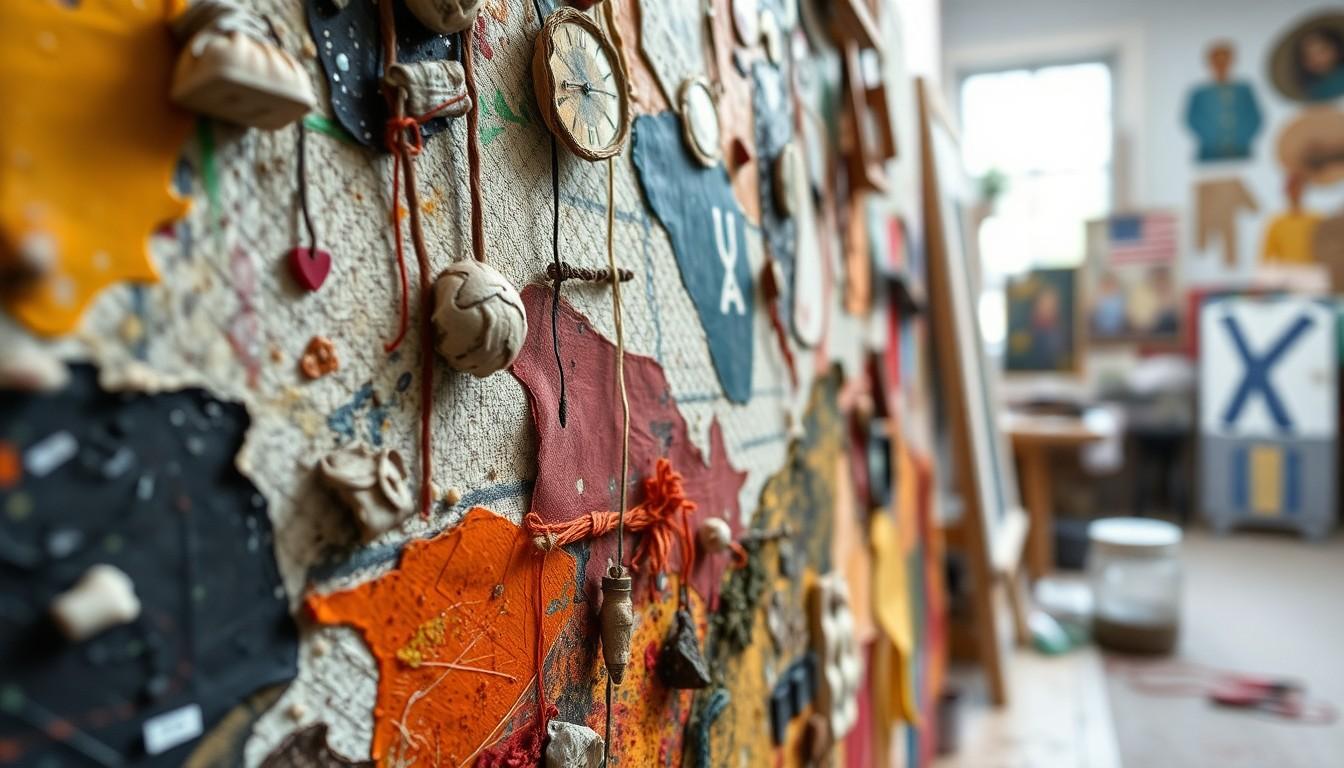Key Takeaways
- Definition of Mixed Media: Mixed media art combines multiple materials and techniques, such as paint, ink, fabric, and found objects, to create unique works that engage viewers through varied textures and innovative forms.
- Historical Context: The mixed media approach emerged in the early 20th century, with pioneers like Pablo Picasso and Georges Braque integrating everyday items into their compositions. This style has continued to evolve, reflecting contemporary themes and personal narratives.
- Techniques Involved: Key techniques in mixed media include layering various materials for depth and incorporating textures to enhance sensory engagement, allowing for complex visual experiences.
- Notable Artists: Influential mixed media artists like Robert Rauschenberg, Anna Mendieta, and Yayoi Kusama have expanded the genre by exploring diverse themes and unique materials, showcasing the emotional depth and versatility of mixed media.
- Creative Advantages: Mixed media fosters innovative artistic expression by allowing artists to experiment with different materials and techniques, promoting versatility and encouraging rich dialogue between the artwork and its audience.
- Engagement with Art: The multifaceted nature of mixed media art invites viewers to experience and interpret works on various levels, enhancing appreciation and emotional connections to the pieces.
Mixed media in visual arts is a vibrant and dynamic approach that combines various artistic materials and techniques. Artists use everything from paint and ink to fabric and found objects, creating unique works that challenge traditional boundaries. This versatility allows for endless creative possibilities, inviting viewers to experience art in new and exciting ways.
In a world where creativity knows no limits, mixed media stands out as a powerful means of expression. It encourages artists to experiment and innovate, often resulting in pieces that evoke emotion and provoke thought. Understanding mixed media not only enriches one’s appreciation of art but also inspires budding artists to explore their own creative journeys.
What Is Mixed Media In Visual Arts
Mixed media in visual arts combines various materials and techniques to create unique artistic expressions. This approach allows artists to transcend traditional boundaries, enhancing their creative potential.
Definition of Mixed Media
Mixed media art refers to works that incorporate multiple materials and methods, including paint, ink, fabric, paper, and found objects. Artists blend these elements to develop a holistic piece that engages viewers through varied textures and innovative forms. The incorporation of diverse materials encourages experimentation, enhancing the visual and tactile experience.
Historical Background
The emergence of mixed media can be traced back to the early 20th century. Artists like Pablo Picasso and Georges Braque pioneered collage, integrating newspaper clippings and everyday items into their compositions around 1912. The movement continued to evolve through subsequent art movements, such as Dadaism in the 1920s, which embraced randomness and the combination of varied materials. Today, mixed media remains a vital form of expression, allowing artists to reflect contemporary themes while exploring personal narratives and social commentary.
Techniques Used in Mixed Media

Mixed media artists employ various techniques to create depth and interaction in their artworks. Two significant methods include layering techniques and the incorporation of textures.
Layering Techniques
Layering techniques involve the application of multiple materials and media to build depth in a piece. Artists often integrate paint, paper, and found objects in successive layers. This approach adds complexity and visual interest. For instance, collage elements can provide a narrative backdrop, while paint can enhance or transform the surface. Artists may utilize transparent materials, like gels or stencils, to create subtle overlays, allowing underlying layers to influence the overall composition. This method encourages creativity, offering opportunities to experiment with forms and colors.
Incorporation of Textures
Incorporation of textures plays a crucial role in mixed media artwork. Artists utilize various materials—such as fabric, sand, or metal—to introduce tactile elements. Textured surfaces enhance visual intrigue and engage viewers on multiple sensory levels. For example, artists might apply thick paint or use techniques like impasto for a three-dimensional effect, inviting closer inspection. Additionally, layering different textures can achieve contrasts that draw attention to specific areas of the artwork. This rich interplay of surfaces creates a dynamic experience, encouraging deeper engagement with the final piece.
Popular Artists and Their Works
Numerous artists have made significant contributions to the mixed media genre, creating impactful pieces that explore diverse themes and techniques.
Notable Mixed Media Artists
- Pablo Picasso
Picasso’s innovative use of collages led to distinct mixed media compositions, integrating materials like newspaper and fabric to challenge artistic norms.
- Robert Rauschenberg
Rauschenberg’s “Combines” blur the line between painting and sculpture, incorporating everyday items such as pillowcases and lightbulbs, promoting a new artistic dialogue.
- Anna Mendieta
Mendieta merged her environment with mixed media elements in her “Silueta” series, using natural materials to explore identity and connection to nature.
- Kara Walker
Walker employs cut-out silhouettes and intricate patterns in her work, addressing complex themes of race, gender, and history through mixed media techniques.
- Yayoi Kusama
Kusama’s distinct use of polka dots and immersive installations blends materials like fabric and paint, creating sensory experiences that reflect her psychological explorations.
Iconic Mixed Media Artwork
| Artist | Title | Year | Description |
|---|---|---|---|
| Pablo Picasso | “Still Life with Chair Caning” | 1912 | Combines oil paint, rope, and wall paper to create texture and depth. |
| Robert Rauschenberg | “Bed” | 1955 | Integrates a real bed into a painting, blurring the boundaries of art. |
| Anna Mendieta | “Silueta Series” | 1973-1980 | Uses natural materials to create forms and traces, connecting the body to land. |
| Kara Walker | “A Subtlety” | 2014 | Features a massive sugar-coated sphinx-like sculpture reflecting historical narratives. |
| Yayoi Kusama | “Infinity Mirror Rooms” | 1965-present | Creates immersive environments using mirrors and lights to explore infinity. |
Iconic works by these artists exemplify the versatility and emotional depth that mixed media offers, showcasing the medium’s capacity to engage audiences and provoke thought.
Benefits of Using Mixed Media
Mixed media offers several advantages for artists, enhancing their creative processes and the overall impact of their works. This approach fosters unique forms of artistic expression and innovation that resonate with audiences.
Creative Expression
Creative expression thrives in mixed media as it allows artists to combine disparate materials and techniques. Artists can experiment freely with paint, fabric, and found objects, which leads to innovative combinations that reflect personal narratives or societal themes. This freedom encourages artists to explore new ideas without the constraints typically found in traditional art forms. The interplay of various mediums creates distinct aesthetic experiences that engage viewers on multiple levels, inviting emotional connections and interpretations.
Versatility in Art Creation
Versatility defines mixed media as it encompasses a broad range of materials and techniques, enabling artists to work in ways that best suit their artistic vision. Mixing traditional elements like painting and drawing with non-traditional items such as photographs or digital media allows for limitless possibilities. Artists can manipulate textures, colors, and forms, tailoring their approach to the content they wish to convey. This adaptability not only enhances the artistic process but also fosters an enriched dialogue between the artwork and its audience.
Testament To Creativity And Innovation
Mixed media in visual arts stands as a testament to creativity and innovation. By blending diverse materials and techniques artists can craft pieces that resonate on multiple levels. This approach not only challenges traditional art forms but also invites viewers to engage with art in new and meaningful ways.
The rich history and evolution of mixed media showcase its enduring relevance in contemporary art. As artists continue to explore personal narratives and societal themes through this versatile medium they inspire others to break boundaries and embrace their own creative journeys. Mixed media remains a powerful platform for expression encouraging a dynamic dialogue between the artwork and its audience.
